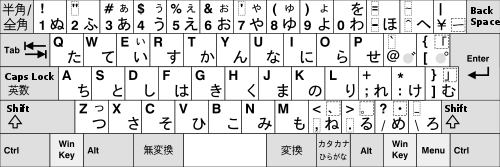Keys for Japanese keyboards


The OADG 109A and older 109 keyboard layouts which are the standard for Microsoft Windows have five dedicated language input keys: [1]
- halfwidth/fullwidth (hankaku/zenkaku 半角/全角) at the top left key of the keyboard;
- alphanumeric (eisū 英数), combined with non-language specific key ⇪ Caps Lock;
- non-conversion (muhenkan 無変換), on the left of the space bar;
- conversion (henkan 変換), on the right of the space bar;
- hiragana (ひらがな), on the right of the space bar, next to 変換.
Apple keyboards designed for Mac OS X have two language input keys: alphanumeric (英数) and kana (かな).
The keyboards for NEC PC-9800 series, which was dominant in Japan during the 1980s and early 1990s, have three language input keys: kana (カナ), NFER (no transfer, same as non-conversion), XFER (transfer, same as conversion). [2]
For non-Japanese keyboards, the following shortcuts can be used for typing Japanese on English keyboard with Windows:
- Alt+⇧ Shift switch between languages (IMEs)
- Ctrl+⇪ Caps Lock switch to Hiragana
- Alt+⇪ Caps Lock if in alphanumeric mode change to Hiragana, then switch to Katakana
- ⇧ Shift+⇪ Caps Lock switch between full-width Hiragana ↔ full-width alphanumeric (romaji)
- Alt+` (Grave Accent) switch between kana ↔ half-width alphanumeric (romaji)
- Alt+~ (Tilde) toggle kana/direct input
- ↵ Enter no conversion, all previous characters are accepted "as is" (all propositions from IME are rejected)
- Space convert current word (last characters) to the first word in the list of proposals
- 2 3 4 5 6 convert to the 2nd-6th word in the list
- F6 convert selected word/characters to full-width hiragana (standard hiragana): ホワイト → ほわいと
- F7 convert to full-width katakana (standard katakana): ほわいと → ホワイト
- F8 convert to half-width katakana (katakana for specific purpose): ホワイト → ホワイト
- F9 convert to full-width romaji, all-capitals, proper noun capitalization (Latin script inside Japanese text): ホワイト → howaito → HOWAITO → Howaito
- F10 convert to half-width romaji, all-capitals, proper noun capitalization (Latin script like standard English): ホワイト → howaito → HOWAITO → Howaito
Half-width/Full-width
Half-width/Full-width (半角/全角, hankaku / zenkaku) toggles between entering half-width or full-width characters (if 2 versions of same character exists) when IME is on and in Katakana mode or Alphanumeric mode. After MS-IME 98, and also change between IME on and off like Kanji Key.
半角/ 漢字 |
Kanji
Used to switch between entering mainly Japanese (IME on) and English text (IME off). It is not found as a separate key in the modern Japanese 106/109-key keyboard layout. On the Common Building Block (CBB) Keyboard for Notebooks, as many 106/109-key keyboards, the Kanji key is located on the Alt+半角/全角. It is found as a separate key on the IBM PS/55 5576-001 keyboard. On the IBM PS/55 5576-002 keyboard, it is mapped to the left Alt key.
Alphanumeric
Alphanumeric (英数, eisū) toggles alphanumeric characters. In the Japanese 106/109-key layout, it is located on the Caps Lock key. Pressing Alphanumeric/Caps Lock key alone actually means alphanumeric function, a user has to press ⇧ Shift+英数 / Caps Lock key to get the caps lock function.
Conversion
Conversion (変換, henkan) is used to convert kana to kanji. In the Microsoft IME, Conversion selects conversion candidates on highlighted input, and ⇧ Shift+変換 is used to display the previous candidate, or zenkōho (前候補). The alt version of this key is also pronounced zenkōho (全候補), which means "all candidates", shows all input candidates.
前候補 全候補 |
Non-conversion
Non-conversion (無変換, muhenkan) specifies that the kana characters entered are not to be converted into kanji candidates.
Katakana/Hiragana/Rōmaji
Katakana,hiragana,rōmaji (ひらがな / カタカナ / ローマ字, katakana,hiragana,rōmaji) used to switch between hiragana or katakana characters. It can also be found for switching between hiragana, katakana and rōmaji as shown below. Alt+ひらがな / カタカナ / ローマ字 or Ctrl+⇧ Shift+ひらがな / カタカナ / ローマ字 [3] (this feature is printed as Rōmaji (ローマ字) on the same key) toggles between rōmaji input and direct kana input in some IMEs (e.g. Microsoft IME).
カタカナ ローマ字 |
